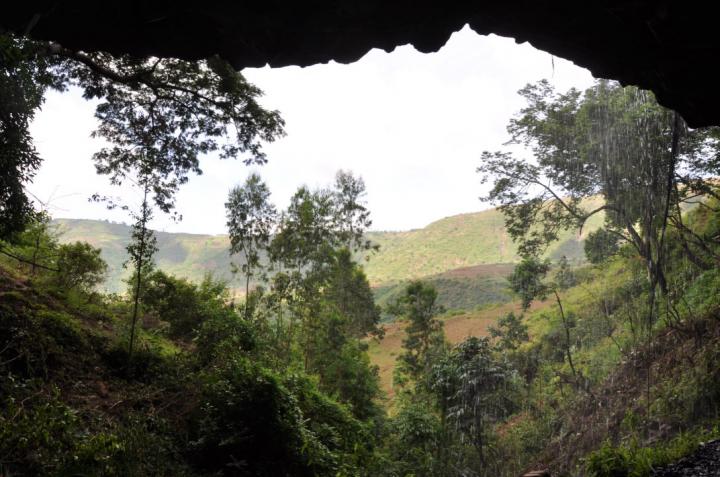DNA reveals 'into Africa' migration
Interview with
Time to look back in time, as this week scientists at the University of Cambridge  have successfully sequenced the genome of a 4,500 year old human discovered recently in Ethiopia. The results reveal how our early ancestors migrated out of and then back into Africa. Andrea Manica is one of the team and told Chris Smith about the work...
have successfully sequenced the genome of a 4,500 year old human discovered recently in Ethiopia. The results reveal how our early ancestors migrated out of and then back into Africa. Andrea Manica is one of the team and told Chris Smith about the work...
Andrea - He's called Mota, indeed. This is a gentleman that lived 4,500 years ago in the southern part of the Ethiopian highlands. He was definitely a hunter-gatherer and we found him in a cave that actually was already in use about 5,000 years ago, and then it was continuously used through time up to about 2,000 years ago as we saw people going from hunter-gatherers to pastoralist then to start producing their food.
Chris - Why was he in the cave? Had he died there?
Andrea - He was actually buried there. So, we find him buried faced down, probably bound as they used to do at that time with some of his tools that he would have used for hunting next to him.
Chris - Quite a dramatic finding. How did you manage to get DNA out of him because I would think that's quite a contaminated site, isn't it?
Andrea - Actually, he was under a very good layer of rock. So, the actual recovered remains were pretty much untouched, and we were already at that time working with the archaeologist, so we managed to get a really nice clean find.
Chris - Where did you get the DNA from? What part of his body?
Andrea - We managed to get it out of what is called the petrous bone which is this little bone that is behind your earlobe. It is just really hard and it preserves DNA really well. It just doesn't get the bacteria coming in and destroying the DNA.
Chris - How did you read the sequence?
Andrea - We have managed to sequence the whole genome, so we have actually got a complete blue print and then we were able at that point to really compare it to other Africans as well as other genomes from the rest of the world.
Chris - Why is this finding of this person at 4,500 years, why is this important in our understanding of modern humans i.e. as where we came from?
Andrea - Well, we came out of Africa as you mentioned before about 56,000 years ago, but we started having some inkling over the last few years looking at modern Africans that western Eurasians might have actually come back in numbers into Africa about 3,000 years ago. So Mota, by living 4,500 years ago, lived just before that time. So, it gives us a really nice reference for what people look like before this wave.
Chris - If one therefore looks at present day Africans and looks at their genome, have you got evidence in modern-day Africans then of - I don't want to use the word 'contamination' but their genome is stuffed full of genes mixed in from people who went out of Africa 50,000, 60,000 years ago, lived in Europe for a while, evolved there for a while and then came back into Africa and bred with those Africans again.
Andrea - We do. We don't quite know whether they made it all the way into Europe proper or maybe they just stopped around the near East Anatolia. But yes, we were quite surprised because even the furthest corners of Africa, like Western Africa or South Africa, actually have about 5 per cent of their genome dating back to this wave of western Eurasians.
Chris - This individual is in Ethiopia. It's quite high -that area. The best marathon runners in the world come from Ethiopia because they've got these genes that give them adaptation to tolerate those low oxygen conditions. Is the same true of this gentleman, Mota?
Andrea - It is indeed. He actually has those key adaptations that we found in Ethiopians right now. They were already there 4,500 years ago and probably, they had already been there for a long time. These were people who had to deal with this complex environment. They were hunter-gatherers, they had to chase down their preys at these altitudes. They were highly adapted for that life.
Chris - And now you have the sequence from Mota, what are you going to be able to do with it which is going to change our understanding of those migration patterns?
Andrea - Well, every time we tried to reconstruct what happened to humans as they come out of Africa, analysis for example of hybridisation with Neanderthal during that time of exit.
Chris - Mixing in with...
Andrea - Mixing in with Neanderthal. We always have to use an African reference. Until now, we always use this modern Africans as our references. So for example in the case of the mixing with Neanderthals, we're actually missing some of the mixing that happened because our reference was already - as you were saying before, had to be contaminated or at least already contain some of those Neanderthal genes.










Comments
Add a comment